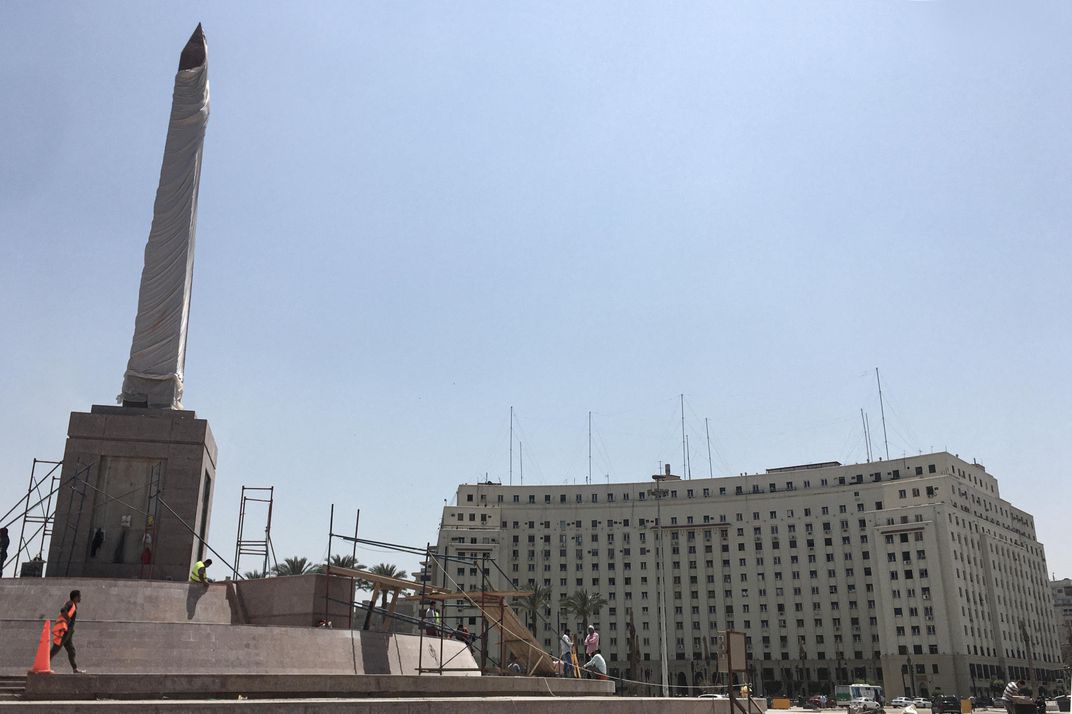Egypt Defies Archaeologists’ Protests by Relocating Four Ancient Sphinxes
Now awaiting unveiling in Tahrir Square, the ram-headed sculptures join a pink granite obelisk dating to the reign of Ramses II
:focal(2807x1604:2808x1605)/https://tf-cmsv2-smithsonianmag-media.s3.amazonaws.com/filer/e4/40/e440ae98-340f-4acc-afd6-c6354468e9a1/2020_may11_sphinx1.jpg)
Despite archaeologists’ protests, the Egyptian Ministry of Tourism and Antiquities has moved four ancient sphinxes from the Karnak temple in Luxor to Cairo’s Tahrir Square, reports Ruth Michaelson for the Guardian. The sphinxes will be stored in wooden crates around the square, located some 300 miles north of their original home, until a still-unscheduled unveiling ceremony.
The ministry announced plans to move the sandstone, ram-head sphinxes from behind the temple to the busy traffic circle in Egypt’s capital at the end of 2019. The decision quickly attracted criticism from archaeologists, who pointed out that placing the sphinxes in a city center would expose them to dangerous environmental conditions. Critics also questioned whether the move violates Egyptian and international regulations regarding the movement of antiquities, reported Gamal Essam El-Din for Ahram Online last December.
Defending the decision, Egyptian Antiquities and Tourism Minister Khaled El-Enany told Ahram Online, “When we go to European capitals like Rome or Paris or London, and also Washington, we see that they use Egyptian obelisks in decorating their major tourist squares, so why do we not do the same?”
Monica Hanna, an archaeologist at the Arab Academy for Science, Technology, and Maritime Transport, set up an online petition opposing the move and suggesting replicas be used in the originals’ stead.
“Decorating western capitals with ancient Egyptian obelisks was a symbol of colonialism, a symbol of the West’s power,” she told the Times’ Magdy Samaan in January. “Are we going to replicate that?”

The four sphinxes were among more than 1,000 sculptures decorating Karnak temple. Stretching across 100 hectares of Unesco World Heritage site and former Egyptian capital Thebes (now known as Luxor), Karnak’s “central sector” is dedicated to sun and air god Amun-Ra, according to Live Science’s Owen Jarus. A road connecting the temple to the ancient city center is flanked by ram-headed sphinxes similar to the ones moved from behind the temple.
Hanna argues that moving the sphinxes is at odds with the Venice Charter, an international conservation agreement that limits the movement of antiquities not in immediate danger.
“These statues are made from sandstone and come from Luxor, where the weather is dry,” she told the Times. “When they are placed in Cairo, the second most polluted city in the world, that will destroy them.”
In February, the Egyptian government installed the foundation of a pink granite obelisk dating to the reign of Ramses II in Tahrir Square. The monument was unearthed in August 2019 in Zagazig, a city in Lower Egypt, reported Egypt Independent’s Mira Maged at the time.
Ostensibly, the Ministry of Tourism and Antiquities’ goal is to transform Tahrir Square into a major tourist attraction. But critics have also suggested that the move is designed to cover the site’s connection to the 2011 uprising that forced President Ḥosnī Mubārak from power. In the years since, Tahrir Square has remained a powerful symbol of the protests.
American University in Cairo political scientist Rabab El Mahdi tells the Guardian that the sphinxes’ relocation “covers over the recent memory … with something historical that has no political connotations or significance.”
Adds El Mahdi, “It’s basically no respect for the living who witnessed this revolution and see it as part of contemporary history, and no respect for the dead, including the antiquities.”